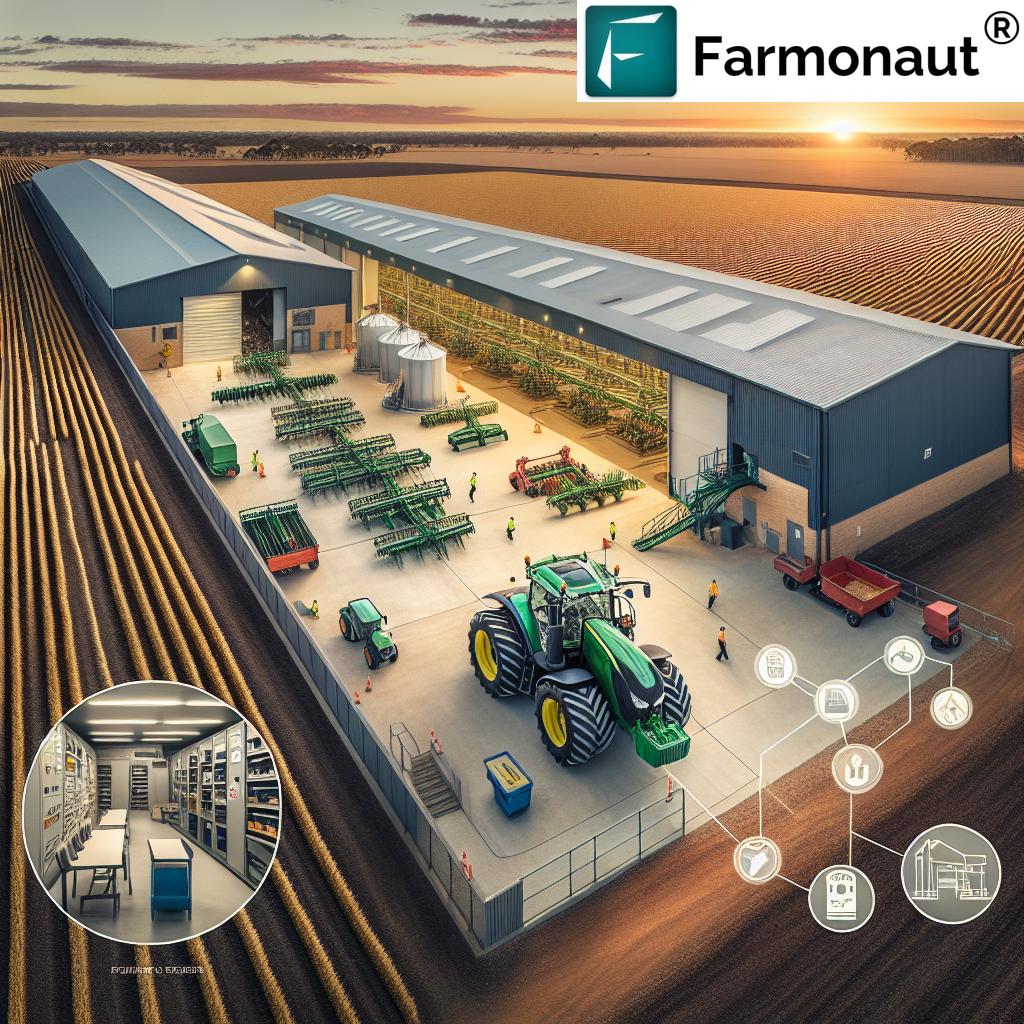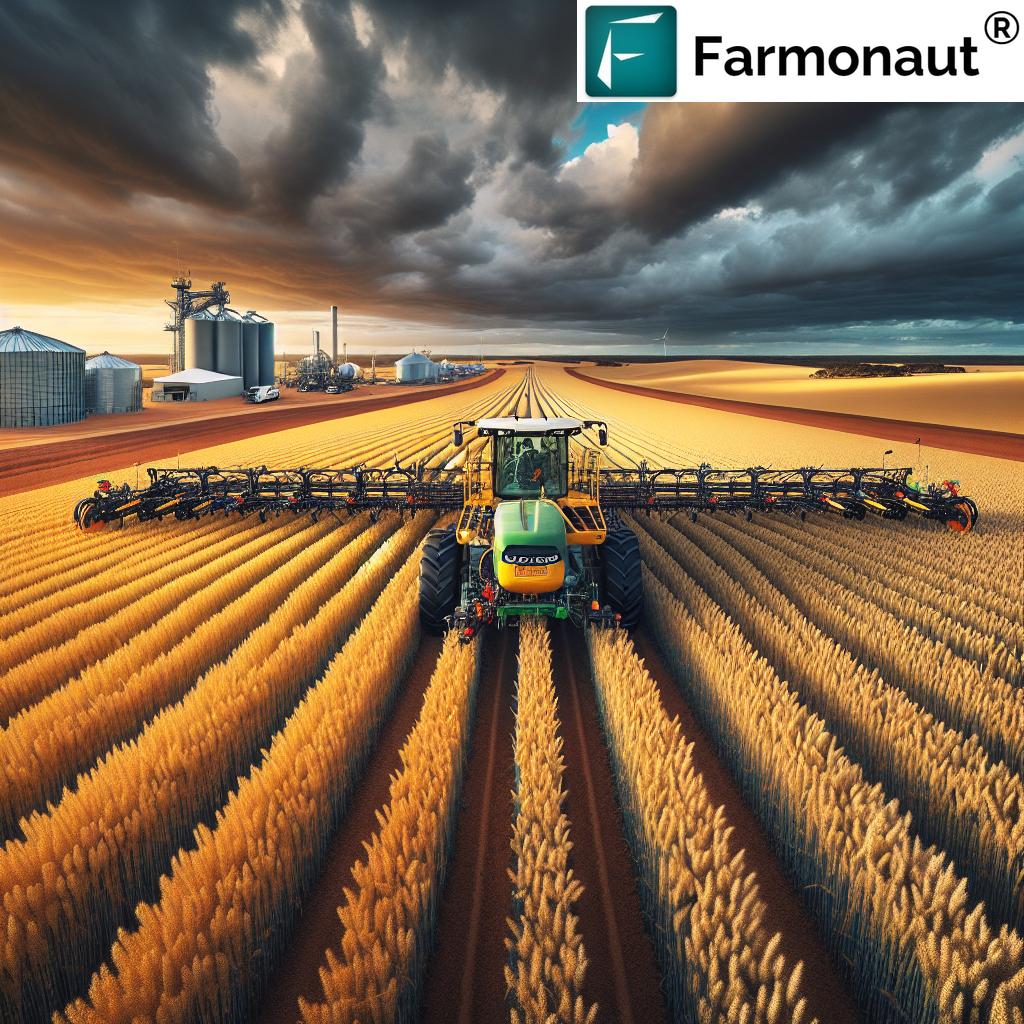Mastering Farm Safety: Essential Tips for Australian Growers to Boost Sustainability and Profitability
“Australian farms with implemented safety measures see up to 30% reduction in workplace accidents annually.”
As we navigate the ever-evolving landscape of Australian agriculture, farm safety has become a cornerstone of sustainable and profitable farming practices. At Farmonaut, we understand the critical importance of implementing robust safety measures to protect our hardworking farmers, their families, and employees. In this comprehensive guide, we’ll explore essential farm safety tips and sustainable farming practices tailored specifically for Australian growers.
From addressing agricultural workshop hazards to emphasizing the proper use of personal protective equipment (PPE), we’ll delve into crucial aspects of farm risk management. Our goal is to help you create a safer work environment, reduce workplace accidents in agriculture, and ultimately foster a more sustainable and profitable industry.

The Importance of Farm Safety in Australian Agriculture
Australian agriculture is a vital sector of our economy, but it also comes with inherent risks. From heavy machinery operations to exposure to chemicals and unpredictable weather conditions, farmers face numerous hazards daily. By prioritizing safety, we not only protect our workforce but also enhance productivity and sustainability in the long run.
At Farmonaut, we’re committed to supporting Australian growers with innovative solutions that complement safety practices. Our satellite-based crop monitoring and AI-driven advisory systems can help farmers make informed decisions, reducing the need for risky manual inspections in certain situations.
Essential Farm Safety Tips for Australian Growers
Let’s explore some crucial farm safety tips that every Australian grower should implement:
1. Workshop Safety: Minimizing Agricultural Workshop Hazards
- Maintain a tidy workspace: Keep your workshop organized and free from clutter to prevent trips and falls.
- Proper tool storage: Store tools and equipment safely when not in use to avoid accidents.
- Adequate lighting: Ensure your workshop is well-lit to prevent eye strain and accidents.
- Ventilation: Proper ventilation is crucial, especially when working with chemicals or welding equipment.
Remember, a well-organized workshop not only enhances safety but also improves efficiency in your daily operations.
2. Personal Protective Equipment (PPE) in Agriculture
“Proper PPE usage in agricultural settings can prevent 75% of common farm-related injuries and illnesses.”
Personal Protective Equipment is your first line of defense against many farm hazards. Essential PPE for Australian farmers includes:
- Safety glasses or goggles: Protect your eyes from dust, debris, and chemical splashes.
- Hearing protection: Use earplugs or earmuffs when operating loud machinery.
- Respirators: Wear when handling chemicals or working in dusty conditions.
- Gloves: Choose appropriate gloves for different tasks (e.g., chemical-resistant gloves for handling pesticides).
- Steel-toed boots: Protect your feet from heavy objects and provide good traction.
- Sun protection: Wide-brimmed hats and sunscreen are crucial in the Australian climate.
At Farmonaut, we emphasize the importance of PPE through our advisory systems, reminding farmers of appropriate safety gear based on current farm conditions and activities.
3. Fire Safety on Farms
Australian farms are particularly vulnerable to fire risks, especially during dry seasons. Implement these fire safety measures:
- Create firebreaks: Maintain clear areas around buildings and crops to slow fire spread.
- Install fire extinguishers: Place appropriate fire extinguishers in key locations and train all workers on their use.
- Develop an evacuation plan: Ensure all workers know the emergency procedures and meeting points.
- Regular equipment maintenance: Keep machinery in good condition to prevent electrical fires.
- Safe storage of flammable materials: Store fuel, chemicals, and hay properly to reduce fire risks.
Our satellite-based monitoring at Farmonaut can help identify dry areas on your farm, allowing you to take preemptive measures against potential fire hazards.
4. Electrical Safety in Agricultural Workshops
Electrical hazards are a significant concern in farm workshops. Follow these guidelines to ensure electrical safety:
- Regular inspections: Have a licensed electrician inspect your electrical systems annually.
- Proper grounding: Ensure all equipment is properly grounded to prevent electric shocks.
- Use of RCDs: Install Residual Current Devices (RCDs) on all power circuits.
- Avoid overloading: Don’t overload power boards or use damaged extension cords.
- Waterproofing: Use waterproof electrical fittings in damp areas.
Explore Farmonaut’s API for advanced farm management solutions
5. First Aid Preparedness for Farmers
Being prepared for emergencies is crucial on Australian farms. Ensure you have:
- Well-stocked first aid kits: Place kits in easily accessible locations around the farm.
- Trained personnel: Ensure at least one person on the farm is trained in first aid.
- Emergency contact information: Display emergency numbers prominently.
- Communication devices: Ensure reliable communication methods are available across the farm.
Remember, quick response to injuries can significantly reduce their severity and long-term impact.

Implementing Farm Risk Management Strategies
Effective farm risk management goes beyond addressing individual hazards. It involves creating a comprehensive safety culture on your farm. Here are some strategies to consider:
1. Develop a Farm Safety Policy
Create a written safety policy that outlines your commitment to farm safety. This policy should:
- Clearly state safety goals and expectations
- Define roles and responsibilities for safety implementation
- Outline procedures for reporting and addressing safety concerns
- Be regularly reviewed and updated
At Farmonaut, we encourage our users to integrate safety policies into their overall farm management strategies, which can be supported by our data-driven insights.
2. Conduct Regular Safety Audits
Perform thorough safety audits of your farm regularly. This involves:
- Inspecting all equipment and machinery for potential hazards
- Reviewing safety procedures and their effectiveness
- Identifying areas for improvement in safety practices
- Documenting findings and creating action plans for addressing issues
Our satellite monitoring and AI advisory systems can complement these audits by providing data on crop health and environmental conditions that may affect safety.
3. Implement Safe Work Procedures
Develop and document safe work procedures for all farm activities. These should include:
- Step-by-step instructions for performing tasks safely
- Required PPE for each task
- Potential hazards and how to mitigate them
- Emergency procedures relevant to the task
Ensure all workers are trained in these procedures and that they are readily accessible for reference.
4. Proper Chemical Management
Chemical safety is crucial on Australian farms. Implement these measures:
- Secure storage: Store chemicals in a locked, well-ventilated area away from living spaces.
- Proper labeling: Ensure all chemical containers are clearly labeled with contents and hazard information.
- Safe handling: Use appropriate PPE when handling chemicals and follow manufacturer’s instructions.
- Spill management: Have spill kits readily available and train workers on their use.
- Disposal: Follow local regulations for safe disposal of chemicals and their containers.
Farmonaut’s precision agriculture tools can help optimize chemical use, potentially reducing exposure risks while maintaining crop health.
Access Farmonaut’s API Developer Docs for advanced integration
5. Equipment and Machinery Safety
Farm equipment and machinery pose significant risks if not properly managed. Follow these guidelines:
- Regular maintenance: Keep all equipment well-maintained and serviced.
- Operator training: Ensure all workers are properly trained on equipment use.
- Guards and shields: Keep all safety guards and shields in place on machinery.
- Safe storage: Store equipment safely when not in use, especially implements with sharp edges.
- Child safety: Keep children away from operating machinery and implement “safe play areas” on the farm.
Sustainable Farming Practices for Australian Growers
Integrating sustainable practices with farm safety not only protects workers but also contributes to long-term farm viability. Consider these sustainable farming practices:
1. Conservation Tillage
Implement conservation tillage practices to reduce soil erosion and improve soil health. This can include:
- No-till farming
- Minimum tillage
- Strip tillage
These practices not only benefit the environment but also reduce the time spent on potentially hazardous tillage operations.
2. Integrated Pest Management (IPM)
Adopt IPM strategies to reduce reliance on chemical pesticides:
- Use biological controls when possible
- Implement crop rotation to disrupt pest cycles
- Monitor pest populations regularly
- Use targeted pesticide applications only when necessary
IPM not only promotes sustainability but also reduces worker exposure to harmful chemicals.
3. Water Conservation
Implement water-saving techniques to conserve this precious resource:
- Install efficient irrigation systems
- Use drought-resistant crop varieties where appropriate
- Harvest rainwater for farm use
- Monitor soil moisture levels to optimize irrigation
Farmonaut’s satellite-based soil moisture monitoring can help optimize water use, contributing to both sustainability and safety by reducing the need for manual field checks in extreme weather conditions.
4. Biodiversity Promotion
Enhance biodiversity on your farm to support ecosystem health:
- Maintain native vegetation corridors
- Plant windbreaks and shelter belts
- Create habitat for beneficial insects and wildlife
- Implement diverse crop rotations
Promoting biodiversity can reduce pest pressures naturally, leading to less reliance on chemical controls and safer working conditions.
5. Soil Health Management
Prioritize soil health to enhance sustainability and reduce environmental risks:
- Implement cover cropping
- Use compost and organic amendments
- Practice crop rotation
- Minimize soil compaction
Healthy soils not only improve crop yields but also enhance water retention, reducing runoff and associated safety hazards during heavy rains.
Leveraging Technology for Farm Safety and Sustainability
At Farmonaut, we believe that technology plays a crucial role in enhancing both farm safety and sustainability. Here’s how our solutions can contribute to your farm’s safety and sustainability efforts:
1. Satellite-Based Crop Monitoring
Our satellite imagery provides real-time insights into crop health, allowing you to:
- Identify problem areas without physical inspection, reducing exposure to potential field hazards
- Optimize resource use, leading to more sustainable farming practices
- Monitor crop progress remotely, minimizing the need for frequent field visits
2. AI-Powered Advisory System
Our Jeevn AI advisory system offers personalized recommendations that can enhance safety and sustainability:
- Weather forecasts to help plan safe working conditions
- Pest and disease alerts to optimize pesticide use and reduce chemical exposure
- Irrigation advice to conserve water and prevent waterlogging-related hazards
3. Resource Management Tools
Our platform includes tools for efficient resource management, which can:
- Optimize vehicle usage, reducing accident risks associated with unnecessary machinery operation
- Improve overall farm logistics, minimizing worker fatigue and associated safety risks
- Enhance sustainability by reducing fuel consumption and emissions
4. Carbon Footprint Tracking
Our carbon footprint monitoring feature allows you to:
- Track and reduce your farm’s environmental impact
- Identify areas for improving energy efficiency, often leading to safer working conditions
- Demonstrate your commitment to sustainability, which can open up new market opportunities
Farm Safety Checklist for Australian Growers
To help you implement and maintain a robust farm safety program, we’ve created this comprehensive checklist:
| Safety Area | Specific Measures | Implementation Status |
|---|---|---|
| Workshop Safety |
– Organize and declutter workspace – Ensure proper tool storage – Install adequate lighting – Maintain proper ventilation |
[ ] Implemented [ ] In Progress [ ] Not Started |
| Personal Protective Equipment |
– Provide safety glasses/goggles – Supply hearing protection – Ensure availability of respirators – Provide appropriate gloves – Supply steel-toed boots – Provide sun protection gear |
[ ] Implemented [ ] In Progress [ ] Not Started |
| Fire Safety |
– Create and maintain firebreaks – Install fire extinguishers – Develop evacuation plan – Conduct regular equipment maintenance – Implement safe storage of flammables |
[ ] Implemented [ ] In Progress [ ] Not Started |
| Electrical Safety |
– Schedule regular electrical inspections – Ensure proper grounding of equipment – Install RCDs on all power circuits – Avoid overloading circuits – Use waterproof fittings in damp areas |
[ ] Implemented [ ] In Progress [ ] Not Started |
| First Aid Preparedness |
– Stock and place first aid kits – Train personnel in first aid – Display emergency contact information – Ensure reliable communication devices |
[ ] Implemented [ ] In Progress [ ] Not Started |
Conclusion
Mastering farm safety is an ongoing process that requires dedication, awareness, and continuous improvement. By implementing these essential tips and sustainable farming practices, Australian growers can significantly reduce workplace accidents, boost productivity, and contribute to a more sustainable agricultural sector.
Remember, farm safety is not just about compliance; it’s about creating a culture where everyone takes responsibility for their own safety and the safety of others. By leveraging technology, implementing robust safety measures, and adopting sustainable practices, we can ensure that Australian agriculture remains strong, safe, and sustainable for generations to come.
At Farmonaut, we’re committed to supporting Australian growers in their journey towards safer and more sustainable farming practices. Our innovative solutions are designed to complement your safety efforts, providing valuable insights that can help you make informed decisions and minimize risks on your farm.
FAQ Section
Q: How often should I conduct safety audits on my farm?
A: We recommend conducting comprehensive safety audits at least annually, with more frequent checks for high-risk areas or during peak seasons.
Q: What are the most common safety hazards on Australian farms?
A: Common hazards include machinery accidents, chemical exposure, falls from heights, animal-related injuries, and heat stress.
Q: How can I encourage my workers to prioritize safety?
A: Lead by example, provide regular safety training, reward safe behavior, and create an open environment where workers feel comfortable reporting safety concerns.
Q: Are there any government resources available for farm safety in Australia?
A: Yes, organizations like Safe Work Australia and state-specific agricultural departments offer valuable resources and guidelines for farm safety.
Q: How can technology like Farmonaut’s solutions contribute to farm safety?
A: Our satellite monitoring and AI advisory systems can help reduce the need for manual inspections in potentially hazardous conditions, optimize resource use to minimize chemical exposure, and provide real-time data for informed decision-making.
By implementing these farm safety tips and leveraging innovative technologies, Australian growers can create a safer, more sustainable, and more profitable agricultural industry. Remember, safety is not just a practice; it’s a mindset that should be integrated into every aspect of farm operations. Together, we can build a culture of safety that protects our most valuable assets – our people and our land.
















